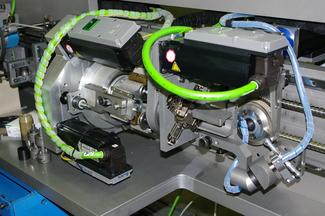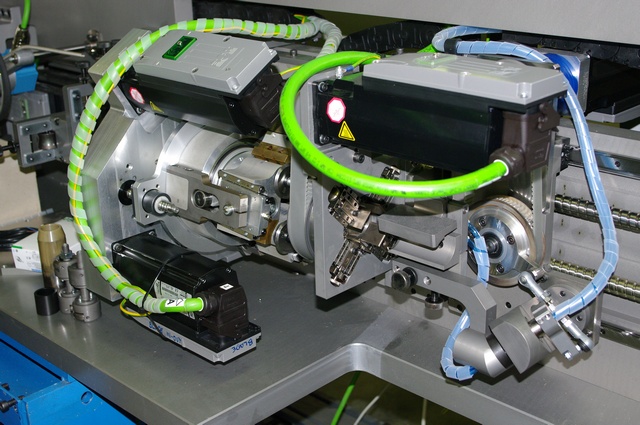
If you Google ‘Motion Design’, the hits are all related to the graphics industry.
As you might suspect, 'Motion Design for Packaging Machines' is very different to 'Motion Design for Graphic Designers'.
This series of blogs discusses why motion design for machines is different.
It is fair to say that machine components move and have mass. If anything has mass, and you want to move it, then its motion design is critical to how the machine component will actually move in the machine.
How critical? Well if you want your machines to perform at their best, without jams, with little maintenance, with the greatest efficiency and throughput…then motion design for your machines is very critical.
Let’s take a look at a Machine Part and see how critical the motion design for it might be.
Let’s imagine your Machine Part is actually your head! Why? Because most people know where their head is! They have also experienced its movement.
OK. Now you are sat, blind-folded, in a chair. Your head, and you, might be at your desk typing a blog, in a car traveling at speed or in a rocket on the way to Mars. Three different velocities. However, because you and your head cannot sense velocity, you will not know which of the three you are experiencing. Your blind-folded head does not know how fast it is traveling.
Your head is a little more concerned about its acceleration. Well its position, too, to be truthful. After all, you do want your head to remain on your shoulders.
Back to acceleration. Let’s imagine you are being interviewed for an astronaut’s job. You are now still blind-folded, but in chair in a centrifuge. You are spinning at constant velocity. Of course your head is being flung outwards.
You are experiencing 'acceleration'. Ignoring blood pressure and other metabolic issues, you will know, even if you are still blindfolded, and if your head isn’t supported, that your neck muscles are straining a little to keep your head in position. With a constant acceleration, your head experiences a constant force and so your neck muscles must offer a constant resistance to prevent your head being flung backwards. As long as your neck muscles are strong enough, and have enough muscular endurance, you can be spun all day. Your neck will eventually get tired of taking the strain, of course, but that is a different matter.
Ok, now for our machine component. It is bolted to the chair and cantilevered over the top of the chair’s head rest. It can sustain the constant acceleration forces quite well when they are a constant value. Machine components will strain of course, like your neck. But unlike your neck, they deflect to a new position. Nevertheless, as long as the lever supporting the machine component is strong enough to 'take the strain', it will usually be strong enough for ever.
Hence, with constant acceleration, the component will deflect to a consistent position.
However, packaging machines have parts that are moved back and forth, as well as remain stationary for 'dwell' periods. Hence, machine Parts must be subject to varying acceleration.
Let’s look at Jerk. Jerk is the rate of change of acceleration.
How does your head ‘feel’ Jerk? Back to the centrifuge. Let's say the centrifuge is varying its speed and thus there is varying acceleration - let's ignore the tangential acceleration and only consider the radial acceleration.
If you are still blind-folded, whenever your neck muscles are in the process of ‘stiffening up more’ or ‘relaxing more’, then they are must be experiencing varying acceleration and thus ‘Jerk’. In other words, the force on your head is varying because acceleration is varying. Varying acceleration requires your neck muscles to vary their effort or exertion in order to keep your head in one place.
How does the Mechanical Component respond to Jerk?
When a mechanical component is subject to ‘varying acceleration’ – jerk - then it will simply deflect to a continuously match the varying acceleration so that the internal and external forces are in equilibrium – won’t it? Yes! And No!
- ‘Yes’: if the rate of change of acceleration is very low.
- ‘No’: if the rate of change of acceleration is very high.
What is very low and very high? Let's imagine a condition where the acceleration changes over time from a 'Acceleration Level 1' to a 'Acceleration Level 2'. Level 2 might be greater or less than Level 1.
If the acceleration is changed from Level 1 to 2 at a 'low rate' (that is, it takes a 'while and, thus, has a low value of jerk - the deflection of the component will more or less be proportional to the acceleration throughout the transition from Acceleration Level 1 to Acceleration Level 2. The component will simply deflect at the same rate as the jerk value. You could use a sensor to detect deflection and calculate the acceleration and thus the speed of the centrifuge.
If the acceleration is varied at a 'high rate' – or has a high value of jerk – the deflection of the component will 'lag' the deflection that would be observed for the' low rate'. Once the acceleration reaches Level 2 the component will then 'catch up' (unwind) and, assuming there is little internal damping, 'overshoot'. The overshoot will be observed in all motion derivatives: position, velocity, acceleration, jerk, jounce, snap, crackle, pop...since they are all related with simple calculus.
So what is rate of acceleration or jerk that is too high for the machine component, or for that matter, for your neck?
For the machine component, it depends on its inertia and stiffness. Low stiffness with high inertia will not respond well, while high stiffness and low inertia will respond well. There is a parameter called Period Ratio. That will be discussed in another blog. Of course, the fastest possible rate of change of acceleration is 'infinite' - that is, infinite jerk. This is a step-change in applied acceleration.

Nothing can respond to a motion that intends to move a machine component with an acceleration that changes from Level 1 to Level 2 in zero time. All mechanical systems that are told to respond to a step-change in acceleration will lag in response to the new force level imposed on it and then overshoot.
Surely, no one would try to apply a instantaneous change in acceleration to a mechanical system if they knew it would lag and then overshoot the desired value of acceleration, velocity and position? That would be exciting vibrations in the system needlessly. Well, you would be surprised. But more of that in a later Blog post.
Try this experiment. Take a steel ruler - one that can easily bend, but not too much. Clamp it, or hold it to the side of a table so it overhangs the table. Suspend a mass above the end of the ruler from 'zero' height - that is, the mass is just touching the ruler. Release the mass. You will observe the ruler deflects and vibrates. It will deflect up to twice the deflection of the 'steady-state' deflection. The ruler was not subject to impact - that is it was not hit - because the mass was initially touching the ruler. The ruler was only subject to a step change in force - equivalent to a step-change in acceleration.
Getting back to your neck. If it was subject to a step-change in acceleration, then to keep your head in one place your neck muscles would need to respond in zero time to take up the new strain that the new force your head exerts on them. Of course, you cannot respond in zero time. Your head would move backwards before the neck muscles respond to pull your head back into position.
With larger changes in acceleration, your neck muscles will further lag the effort they should exert to hold your head in position. Eventually you will strain your neck. No matter how much you try, your neck muscles will not respond to the rate-of-change of acceleration.
Adventure park rides control jerk very closely – otherwise their owners would be responding to lawsuits claiming whiplash.
So, that is a bit about ‘Jerk’ – the important motion design parameter that massively influences vibration of machine components. It's a good job MotionDesigner, our built-in motion design application, allows you to edit the Jerk values to any value you need.
But what makes a good overall motion? That is the subject of the another blog post.

